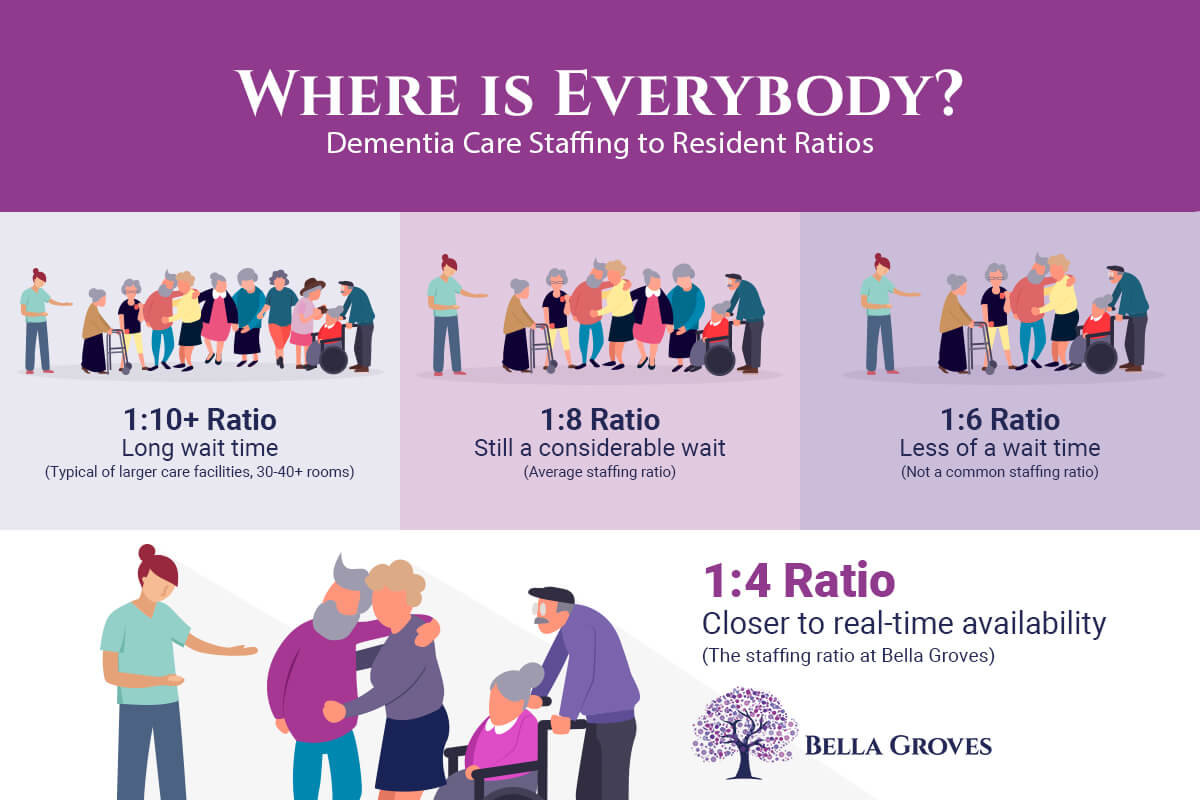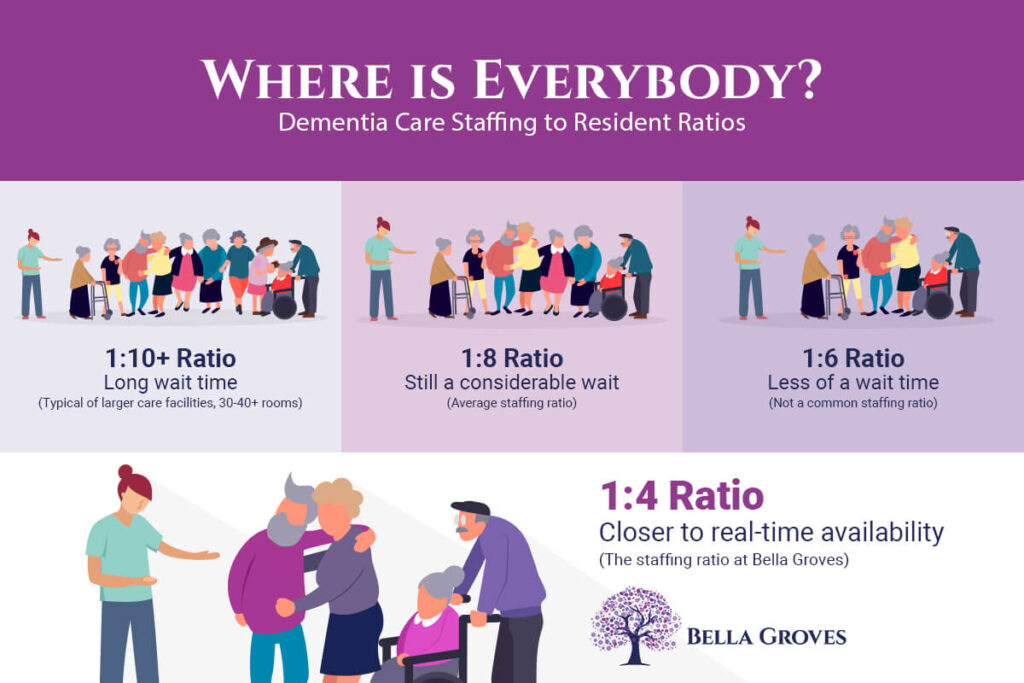
4 Advantages of Better Resident to Staff Ratio in Dementia Care
By: James Lee, Co-Founder & CEO of Bella Groves
All stakeholders (family, resident, company, others) in a dementia care community face numerous challenges that stem from a poor staffing ratio. In Texas, the Assisted Living Facility regulations simply require that a community have sufficient staff to meet the needs of residents. “A facility must develop and implement staffing policies, which require staffing ratios based upon the needs of the residents, as identified in their service plans (Texas Administrative Code).”
This leaves a lot of room for interpretation, and sadly in most cases the guidance of “sufficient” translates in everyday practice to “minimum.” Most senior living companies intend to do well by their residents and also face the practical challenge of balancing business costs and meeting the needs of their residents. With that said, ask any caregiver in a dementia care setting what their top concern is related to their work setting and easily in their top three will be time or staffing.
Poor staffing ratios make things difficult on care staff, and this makes things difficult on residents and families alike. Insufficient staffing leads to caregiver burnout which leads to caregiver turnover. Poor staffing ratios mean residents wait long periods of time between care needs, and it is not uncommon for well-meaning caregivers to rush or even skip past certain care tasks in their judgment of how much time can be invested in a care activity before having to move on to the next task.
For instance, because dementia presents so many unique and changing variables from day to day, a person living with dementia may only need 30 minutes of assistance with a shower one day but need 2 hours later that week. This is problematic for caregivers who are given assignment checklists based on an assumed predictability of time. In other words, they are assigned duties based on time measurements (i.e., 30 minutes for shower; 15 minutes for dressing assistance, etc.), but any family member who has cared for their own loved ones with dementia knows all too well how unpredictable time needs are when it comes to dementia.
Below are the top questions that managers and staff at dementia care communities receive from their current family members. We believe that these questions and their underlying concerns all stem from poor staffing ratios.
For each of these highly prevalent questions, families of dementia care communities typically ask, we provide some insight as to how we think Bella Groves is uniquely solving these problems through better staffing ratios.
Why is it Difficult for Me to Get Accurate Updates on My Mom?
The most common reason families face this challenge of getting accurate care updates is either due to the availability of staff to give the update or poor shift changes where information is not passed down accurately.
Poor staffing ratios mean that caregivers are frequently racing to the finish line at the end of each shift. The most commonly cited frustration by caregivers in senior living is when the past shift doesn’t complete all their work and it rolls over into their shift. Between time crunches to finish tasks and inefficient staffing schedules that don’t have any overlapping time between the outgoing and incoming shift, resident updates aren’t passed in person but rather by shift documentation. Although staff are required to read notes and do shift change reports with one another, in practice, many care teams end up skipping this communication so that the outgoing shift can clock out and the incoming shift can get started with their own long task checklist.
At Bella Groves, our high staffing ratio (1 caregiver to 4 residents) is approximately twice the average in our market when compared to assisted living facilities with at least sixteen residents or more. Each shift has a dedicated “lead” whose sole responsibility on shift is to facilitate a smooth care shift and ensure the accurate flow of communication between shifts and with managers. The leads act as a shift-specific quarterback who jumps in to support care tasks, communicate with families, ensure accurate documentation, and otherwise make sure that each shift runs well.
Is (Caregiver Name) Still Working Here?
The underlying concern here is the frequency of staffing turnover. By most measures of industry analysis, a typical annual turnover rate of 100% is very common in senior living. There is also a correlation of higher turnover based on the acuity of residents’ needs (i.e. higher levels of care need equal higher turnover rates).
In dementia care specifically, staffing turnover poses many challenges to residents who rely on familiarity and trust with established caregivers. The continuity of this gained knowledge and relational shorthand is important to advancing trust and therefore advancing good care routines.
A better staffing ratio means that caregivers are relieved of the typical burdens of constantly feeling short-staffed. We know that employee retention is not just about hiring “good people” – although that is certainly important. Retention also has a lot to do with creating good workflows. Having appropriate or even generous staffing ratios is foundational to improving how care facilities do their work. Employees don’t yearn for more pizza parties. They long for better staffing ratios! Click here to learn more about Bella Groves’ commitment to solving the employee turnover problem in senior living.
Where is Everybody?
Or, Why Does My Mom Have to Wait So Long to Get Help?
The given answer is likely to sound something like, “I’m sorry, I was caring for another resident.” Yes, it is almost always true, but it also means that other residents essentially wait in a mental queue of caregiver teams who have to decide moment to moment whose needs are prioritized and who has to wait.
Let’s say there are two caregivers for twelve residents (1:6 ratio, which is better than most). At any given time, if each caregiver is occupied by a resident, there are ten residents who are self-managing their time. It also means that their care needs must go unmet until one of the caregivers is available. The better the ratio, the less other people have to wait. In dementia care, you can see staffing ratios ranging from 1:10+ to 1:6.

Why is Mom’s Care Bill Going Up (Again)?
By now you must be picking up on a pattern. Many of the concerns families raise in dementia care are related to staffing issues. Whenever care fees are assessed by “level of care” or “ala carte” the presumed benefit is that you only pay for what you need. In reality, dementia care is ever-changing and can be higher for a person in one month and different in the next. Current customers of dementia care communities under this billing method have likely experienced care increases but rarely experience care fees decreasing.
Although your care fees increase due to need (demand for care) – does this change the supply (availability of care)? You’d be hard-pressed to find that caregiver support (in actual labor hours) changes much if at all with care fee changes.
At Bella Groves, part of our operating model is to utilize science, data, and care patterns of certain dementias to help us better understand and predict care needs. Though no one can remove all variability of care needs, senior care facilities can do better to take the guesswork out of the care and cost equation for families. Our commitment to better staffing ratios is rooted in helping our professional caregivers truly meet the needs of our residents – not based on minimum requirements as interpreted by state regulations but by our moral obligation to err on the side of more care availability rather than less.
Putting it All Together
The unspoken – or at least a less commonly addressed – limiting factor for most memory care communities is the business consideration of costs vs. benefits related to care labor and care need. In a challenging business, most organizations face the unenviable task of determining how to “staff appropriately” and fulfill their care responsibilities, pay caregivers in a tight labor market, and try to maintain a profitable business. In a financial sense, organizations typically err on the side of “just enough” than “more than enough” when it comes to care availability. Companies perform time studies to determine what an “average” care task should be in terms of length, but these time studies largely miss the high degree of variability when it comes to caring for someone living with dementia.
The first line of people affected by this rationale are the men and women in the frontlines of dementia care – our professional caregivers. Overworked, overloaded, and overwhelmed, their pain eventually becomes a resident strain.
Could you be “overpaying” at a place like Bella Groves? We don’t think so. We would prefer to err on the side of abundance than schedule scarcity. Few people “desire” to live in a memory care community at the end of their lives, but for people for whom this is the best alternative to living at home, you should have the peace of mind that your money spent is invested primarily on caregivers in terms of staffing, wages, benefits, and retention.
In this case, less isn’t more. More is more.


